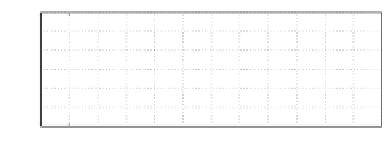Environmental Engineering Reference
In-Depth Information
28
2
P
1
P
2
Q
1
Q
2
24
1
20
0
16
12
−1
8
−2
4
−3
0
−4
−4
0
1
2
3
4
5
6
7
8
9
10
11
12
0
1
2
3
4
5
6
7
8
9
10
11
12
Time [s]
Time [s]
(a) Active power
(b) Reactive power
28
10
E
1
E
2
9
24
20
16
5
12
8
4
1
0
0
1
2
3
4
5
6
7
8
9
10
11
12
0
1
2
3
4
5
6
7
8
9
10
11
12
Time [s]
Time [s]
(c) Voltage set-point
(d) THD of the output voltage
Figure 20.6
Experimental results at 1 : 1 power sharing when the linear load was changed
considerably from 22% to 6
0% for two inverters in
parallel operation, which also shows that the THD of the voltage dropped when two inverters
were put in parallel operation because the output impedance is halved due to the parallel
operation of the two inverters. Hence, accurate power sharing, good voltage regulation and
high voltage quality were all achieved.
Figure 20.8 shows the effect of changing the nonlinear load. The resistance of the load was
changed from 5
.
5% for one inverter and from 16% to 5
.
2 s. Both inverters
shared the load equally during the process and the voltage THD reduced below 5% when the
load was decreased because a smaller current results in a smaller harmonic voltage drop on
the output impedance.
.
7
to 7
.
9
at
t
=
4 s and then changed back at
t
=
9
.
20.2.2
2:1
Power Sharing
In this case,
K
1
=
2 and
K
2
=
4 were chosen. The droop coefficients were set as
n
1
=
0
.
4 and
n
2
=
2
P
2
. The other parameters
remained unchanged. From the Bode plots of the output impedances of both inverters shown in
Figure 20.9, the output impedances of both inverters are resistive at the fundamental frequency
and the output impedances at the 3rd, 5th and 7th harmonic frequencies are again much smaller
than the impedances at the fundamental frequency.
0
.
8;
m
1
=
0
.
1 and
m
2
=
0
.
2. Hence, it was expected that
P
1
=
20.2.2.1 Without a Load
2
3
(
i
1
+
Since the sharing ratio is 2 : 1, the load current component is
i
2
) for Inverter 1 and
i
1
−
2
i
3
, which takes the positive
sign for Inverter 1 and the negative sign for Inverter 2. When there was no load connected to
the inverters, the circulating current is shown in Figure 20.10. It can be seen that the circulating
current is again very small.
1
3
(
i
1
+
i
2
) for Inverter 2. The circulating current component is
±





































































Search WWH ::

Custom Search